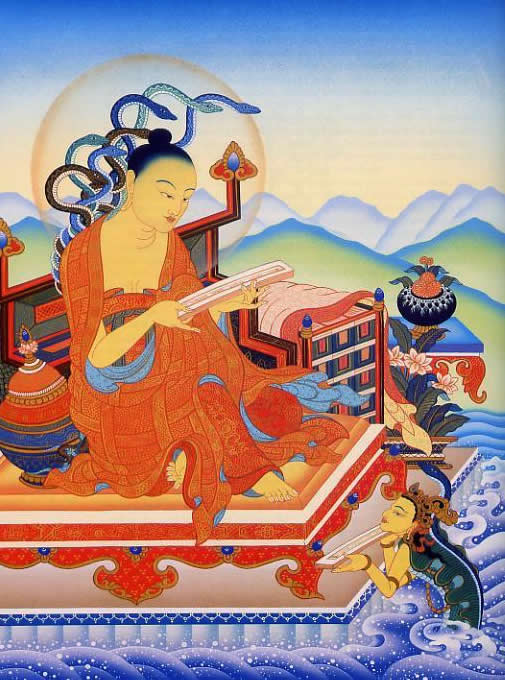
An awkward situation
I find emptiness—especially when understood as a good thing—the most distinctive and valuable teaching of Buddhism. It is also one of the least accessible, least obviously attractive, and least visible from outside the religion. (Every educated Westerner has some idea about Buddhist teaching on karma and compassion—but “emptiness”? No.)
Emptiness is not, I think, necessarily difficult to understand. Books about emptiness are remarkably scarce, though, considering how important it is. And those books are mostly extremely hard going. There is a tangled history behind this.
my nice non-stick spaghetti pot
The first explanations of emptiness were written by Nagarjuna. He was a genius, and his logic is quite straightforward; but it is hard to know what to think about his conclusions. One explanation is in terms of the “Four Extremes,” or fundamental wrong views. He argues that things—pots for instance—are
- not existent;
- not non-existent;
- not both existent and non-existent; and
- not neither existent nor non-existent.
But what is this supposed to mean? And why claim that my nice non-stick spaghetti pot is not existent?
Most Buddhist schools consider that Nagarjuna’s explanations of emptiness must definitely be correct and complete, because they were given to him by nagas: aquatic snake-gods. So scholars have been arguing about how to make sense of them for centuries. These arguments are sometimes brilliant, and fascinating if you are a philosophy geek; but they are extremely abstract, and have little obvious relevance to everyday experience.
Also, divine transmission may not seem as impressive as it once did. Nowadays we are not so interested in arguments from authority (“a god/saint/overgrown cobra said it, so it must be true.”) Being a Parselmouth does not make you seem infallible. Or, as Monty Python’s Dennis would put it,
“Listen—strange creatures lying in ponds distributing texts is no basis for a system of logic! Supreme spiritual power derives from the mandate of nonduality, not from some farcical aquatic ceremony. You can’t expect to wield supreme spiritual power just ’cause some watery worm threw a sutra at you! I mean, if I went around sayin’ I was enlightened just because some moistened monster had lobbed a scripture at me, they’d put me away!”
Meanwhile, Buddhist practitioners have developed various other ways of making sense of emptiness, arising out of meditation practice and observing the texture of experience. These explanations do not clearly relate to the framework (“Madhyamaka”) set out by Nagarjuna and elaborated by numerous other philosophers since.
This is an awkward situation. Madhyamaka is the official teaching on emptiness, but is useless for most people. The informal explanations that students find relevant and helpful do not have a clear basis in the sacred texts. They are mainly taught orally, or are mentioned in passing in non-authoritative books of advice.

A naga offers sutras to Nagarjuna
The Aro gTér explanations of emptiness
The Aro gTér is unusual in including, as formal teachings, explanations of emptiness that are not clearly derived from Madhyamaka. These teachings seem consistent with Madhyamaka—as it is interpreted in the Nyingma Tradition—but they go beyond it.
The Aro explanations also seem consistent with the informal, oral tradition found in other lineages that emphasize formless meditation. They will not seem surprising or alien to anyone who has practiced Zen, Formless Mahamudra, or in other Dzogchen lineages.
ten qualities of experience
The Aro gTér is unique, so far as I know, in organizing its explanations of form and emptiness around the five elements of Dzogchen (or equivalently the five Buddha Families of Tantra). Form is explained in terms of the five qualities of solidity, permanence, separateness, continuity, and definition. Emptiness is explained in terms of the seeming opposites—insubstantiality, transience, boundarilessness, discontinuity, and ambiguity. Although the Aro gTér sometimes speaks of existence and non-existence, its main explanations are in terms of these ten qualities of experience, instead.
The Aro gTér also describes a different set of Four Extremes: eternalism, nihilism, monism, and dualism. Again this is unique as far as I know [see update below]. Eternalism and nihilism relate closely to Nagarjuna’s first two Extremes (existence and non-existence). They are also explicitly two of the Four Extremes in a famous text by Padmasambhava, Explanations of the Variety of Philosophies.1
Monism and dualism are sometimes discussed in the Madhyamaka tradition as relating to eternalism and nihilism, but not as errors of comparable or independent importance. Monism is the belief that “all is One,” or “my true, deep self is mystically identified with the universe as a whole.” Dualism is the belief that “I am clearly distinct from everything else.”
These are common wrong ideas (whereas few people believe pots are “both existent and non-existent” or “neither existent, nor non-existent”). Monist thinking is typical of the New Age, but has recently “escaped” into our cultural thought soup, where it is wreaking havok on everyone’s ability to make sense of the relationship between self and the world. Mainstream Western religions are dualist, believing in a soul that is separate from everything else.
[Update: Jayarava has pointed out that the Four Extremes of eternalism, nihilism, monism, and dualism appear in the Pali Canon, in the Lokayatika Sutta. The Buddha, in conversation with a cosmologist, rejects these Four Extremes. It was surprising, but gratifying, to find precedent for the Aro view in a seemingly-unrelated scripture.]
celebrate form as the basis of compassion and appreciation
The Aro gTér is somewhat unusual in giving equal value to form and emptiness, and emphasizing their nonduality. The best-known interpretations of Madhyamaka are rooted in Sutrayana, which prioritizes emptiness over form. From point of view of Sutrayana, form is impure and contaminating, and should be renounced. Versions of Madhyamaka that are based in Tantra or Dzogchen celebrate form as the basis of compassion and appreciation. Such interpretations are typical of the Nyingma Tradition.
I have found the Aro presentation of form and emptiness, of their nonduality, and of the Four Extremes, hugely helpful in understanding everyday experience, meditation experiences, and formal teachings on emptiness such as Madhyamaka.
Currently, there is no Aro text specifically devoted to this subject. However, it is a main topic of Ngakpa Chögyam’s Spectrum of Ecstasy, among other works.
Meaningness, emptiness, and the Aro gTér
My Meaningness site works out practical consequences of the Four Extremes as I understand them from the Aro gTér. It is not actually an Aro gTér presentation (I am not qualified to do that), or even a Buddhist one. It is meant to be useful to anyone, whether or not they are Buddhists, so I don’t use the word “emptiness,” which would be misleading. (And I don’t want to get into arguments there about whether my understanding of emptiness is correct—a favorite sport for Buddhist scholars.)
However, Buddhists may find much of interest there, reflecting at least the informal tradition of emptiness explanation.
- 1.The title is Man ngag lta ba’i phreng ba in Tibetan. The other two Extremes in this text are different from both Nagarjuna and the Aro gTér.
